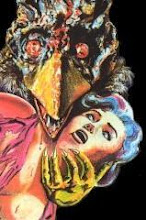 This afternoon I took the time to watch Kinji Fukasaku's 1975 yakuza film Graveyard of Honor. Fukasaku is perhaps most famous amongst youngsters as the director of Battle Royale (2000), the film in which schoolchildren are pitted against each other on an island and forced to fight to the death. Before Battle Royale went into production, though, Fukasaku had already had a lengthy and productive directorial career. Fukasaku was particularly well-versed in the crime genre. His five film series The Yakuza Papers (1973-74), in particular, stands as a landmark moment in the yakuza genre for many film historians and critics.
This afternoon I took the time to watch Kinji Fukasaku's 1975 yakuza film Graveyard of Honor. Fukasaku is perhaps most famous amongst youngsters as the director of Battle Royale (2000), the film in which schoolchildren are pitted against each other on an island and forced to fight to the death. Before Battle Royale went into production, though, Fukasaku had already had a lengthy and productive directorial career. Fukasaku was particularly well-versed in the crime genre. His five film series The Yakuza Papers (1973-74), in particular, stands as a landmark moment in the yakuza genre for many film historians and critics.
All that being said, I was pretty unawre of Kinji Fukasaku's pre-Battle Royale output before this year. I first became interested in his sixties and seventies films after watching the relatively obscure Blackmail Is My Life (1968) on Netflix. Though I watched it on a mere whim, I walked away impressed with the incredibly stylish and amoral world presented in the film. Despite being over forty years old, Blackmail still felt fresh and hip and I became interested in seeking out similar fare.
Which leads me, of course, to Graveyard of Honor. I viewed Graveyard today with moderate expectations that were exceeded by the wild and frenetic ride that the movie presented. Regarding plot Graveyard of Honor is basically your standard rise and fall story, though the movie places considerably greater emphasis on the protagonist's fall from power than his ascent. But with a descent this spectacular, bloody, and dramatic, such a choice is difficult to argue with.
The film's self-destructive protagonist is Rikio Ishikawa (played by Tetsuya Watari, who might be most recognizable to American audiences as the lead in 1966's Tokyo Drifter), a hyper-violent yakuza with a severe lack of impulse control. Ishikawa sees himself as a balloon, which continuously rises through the air until it inevitably pops. The balloon metaphor is echoed multiple times in the film's visuals. At various points in the movie there are shots in which a singular red balloon is prominently displayed on screen. Far from being cheesy, I found the balloon motif to be an effective way of creating a visual link between all the different various events in the film. Shots of the balloon serenely floating in the air also made for a chilling and effective juxtaposition against the chaotic violence of the rest of the movie.
Speaking of the violence, I was impressed with how disorienting and frenetic the film's moments of violence were. Blood flows freely here, in shockingly vibrant shades of red. True, the blood on display in Graveyard of Honor looks very garish and 1970's, but to me that only adds to the brashness of the action and the retro appeal of the film.
Rikio Ishikawa, the film's aforementioned lead, is the most frequent and unpredictable perpetrator of the bloodshed. As such he's a difficult character to sympathize with fully, but he's a thrilling figure to watch. Ishikawa moves with an animalistic intensity, cutting and gutting anyone who dares get in his way. From the outset it is clear that Ishikawa is on the fast track to complete self-destruction, but one might be surprised at the havoc he will cause and the trials he must endure before getting there.
Those in the market for bold films with style to spare should give Graveyard of Honor a go. Watching this film fueled my desire to further explore Japanese crime movies, and, as always, I look forward to learning more.

This was a very well written post, academic really. I thought of 99 Luft Balloons when I read the part of the red balloon.
ReplyDeleteI really like it when directors use color in a very deliberate way, like the red motif in this film. I'm reminded of the green lens in Madonna's Power of Goodbye video--her character drowns herself in the end, so it created a sense of submersion.
I love Battle Royale! Japan is the land of amazing film makers